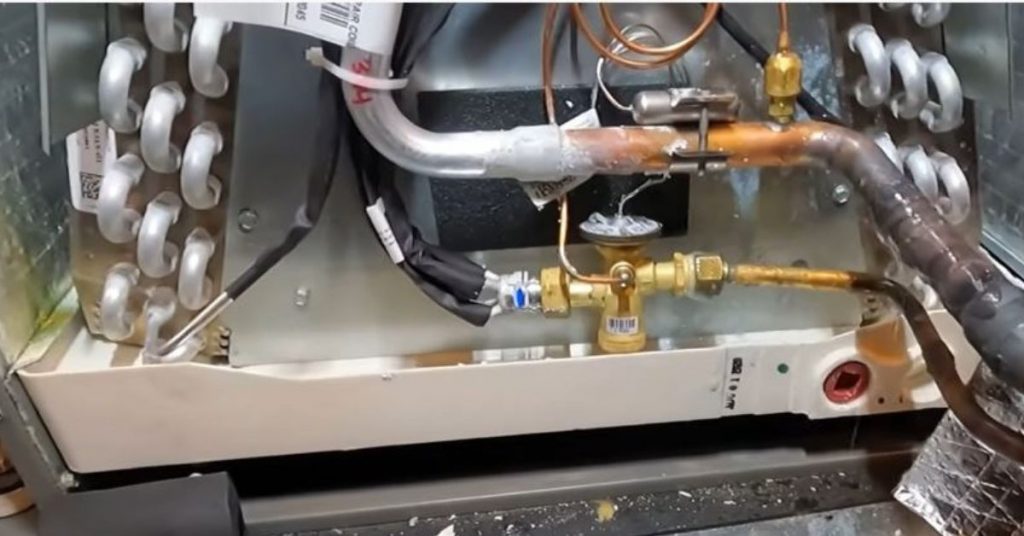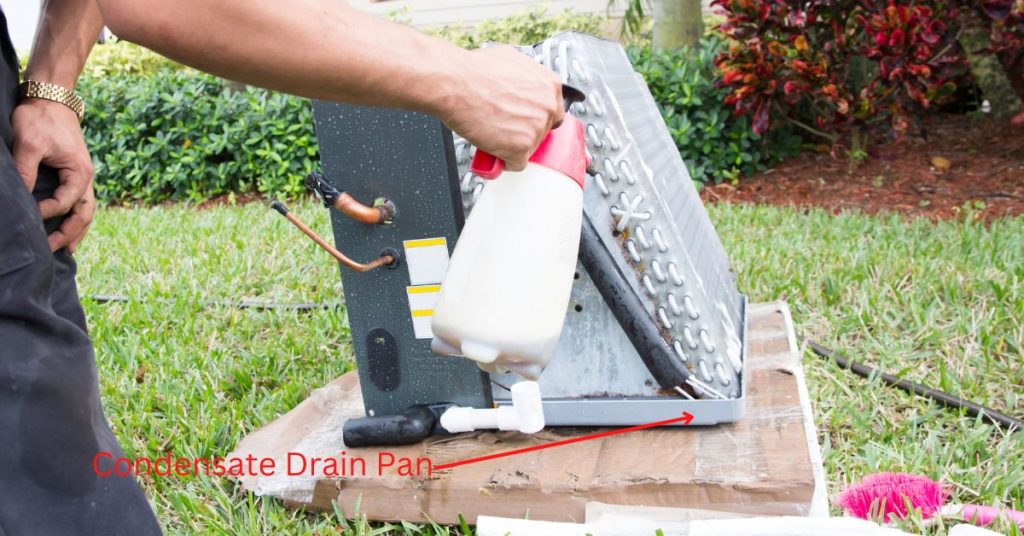
A condensate drain pan is a crucial component in air conditioning systems, designed to manage and remove the moisture that accumulates during the cooling process. Here’s a summary of what a condensate drain pan is and how it works:
- Purpose of a Condensate Drain Pan: The condensate drain pan, also known as a drip pan or condensate pan, is a shallow, typically metal or plastic container located beneath the indoor evaporator coil of an air conditioner or HVAC unit.
- Collecting Condensate: The primary function of the drain pan is to collect condensate, which is the water that forms when warm, humid indoor air is cooled by passing over the cold evaporator coils. This process causes moisture in the air to condense into water droplets.
- Drainage Mechanism: The collected condensate in the drain pan is typically drained away through a drain line or pipe. The drain line directs the water to a suitable disposal location, such as a drainage system, a sump pump, or an exterior location away from the building.
- Prevention of Water Damage: The drain pan serves as a safety feature to prevent water damage to the building. Without a properly functioning drain pan and drainage system, condensate could overflow, leading to water leakage that can damage ceilings, walls, and flooring.
- Maintenance and Algae Prevention: Regular maintenance of the drain pan is essential to ensure that it remains clean and free from obstructions. Over time, dirt, debris, and algae can accumulate in the pan or drain line, potentially leading to clogs. Cleaning and maintenance prevent these issues and maintain efficient drainage.
- Float Switches: In some AC systems, a float switch is installed within the drain pan. This switch is designed to detect an unusually high water level in the pan. When triggered, it shuts down the AC system to prevent further condensate production and potential water damage. Float switches are an added layer of protection for homes.
How a Condensate Drain Pan Works
To understand how a condensate drain pan works, I feel like it is also important to also know how an air conditioner works. I have written a detailed guide on that here but I will now write down a short summary.
Your air conditioner has 4 main components:
- Evaporator coil
- Compressor
- Condenser coil
- Expansion valve
To effect heat exchange (cooling), a refrigerant also known as a coolant is circulated between the 4 components where it changes state from liquid to gas and back to liquid again due to its low boiling point.

This is the cooling cycle happens:
- Inside the evaporator coil (located inside the house), the refrigerant will be a very cold liquid. It will absorb heat from the indoor air and evaporate, turning to its gas/vapor form.
- From the evaporator the refrigerant gas enters the compressor where its pressure is increased, which also increases its temperature. The compressor is located outside together with the condenser coil.
- Now that the temperature of the refrigerant is higher than the outside air, heat can be transferred from the refrigerant to the surrounding air inside the condenser coil. That is accelerated by the condenser fan. Here, the refrigerant condenses to a liquid.
- The expansion valve expands the refrigerant, lowering its pressure. A reduction of pressure also means a drop in temperature. The now cold refrigerant enters the evaporator coil and the cycle goes on and on.
Since the condensate drain pan is part of the evaporator coil, we focus more on the evaporator coil.
The evaporator coil is located inside the house since it is the AC component responsible for actually cooling the air. It is connected to both the return and supply air ducts.
Return air ducts carry warm indoor air from the house to the coil while supply air ducts carry air-conditioned air from the coil back to the house. The return air is first passed through an air filter to remove dirt particles before getting to the coil.
If you have a central air conditioner, it will be paired up with a furnace (gas or electric). However, if you have a heat pump, it will be paired up with an air handler.
Your HVAC system will have a fan/blower which will pull warm air from the house to the coil via the return air ducts. It will also force cooled air back to the house via the supply air ducts.
When the warm air from the house comes into contact with evaporator coil, the cold refrigerant inside the coil will absorb heat from the air, cooling it in the process. Refrigerants have a high latent heat of vaporization.
As you already know, indoor air contains lots of water vapor known as humidity. High levels of humidity are undesirable.
From the water cycle, you would know that when water vapor is subjected to low temperatures, it condenses. Condensation simply means that vapor changes to liquid. And that is what happens on the surface of the evaporator coil.
As the indoor air is cooled, the water vapor condenses and drips on the condensate drain pan. The pan should not hold the water though. A drain line connected to the pan (condensate drain line) discharges the water outside the house.
Water formed as a result of condensation is known as a condensate. HVAC pros will there use the terms water and condensate interchangeably.
Where is the Condensate Drain Pan Located?

The location of a condensate drain pan depends on the type of HVAC system you have. There are 2 types of HVAC units:
- Vertical units
- Horizontal Units
In vertical HVAC units, the furnace or air handler are in an upright position. The return air duct enters the unit from the bottom while the supply air duct is connected from the top.
In these vertical HVAC systems, the evaporator coil is located at the top of the unit and the condensate drain pan can be found directly below it. As such, these units have 1 condensate drain pan.
In horizontal HVAC units, the air handler or furnace are installed on their side. The return air duct enters from one side of the unit while the supply air duct leaves from the other side. Such installations are common in attics where space is problem.
Unlike in upright units where air moves upwards and the condensate can only drain in a specific place, in horizontal units the condensate has the potential to drain all over the unit. Even though the condensate drain pan is located under the evaporator coil, the unit has a secondary condensate drain pan.
The secondary condensate drain pan works as failsafe for the primary one, preventing your unit and home from water damage. For context, a condensate drain pan can collect up to 20 gallons of condensate in a day.
20 gallons of water is a lot of water and can badly damage your wooden floor, ceiling, drywall and other parts of the house. If therefore your primary condensate pan fails, the secondary pan comes into play.
Unlike the primary condensate drain part which is smaller, hard to see and only sits below the evaporator coil, the secondary condensate drain pan is easy to see as it sits below the unit covering its entire depth and width.
Should a Condensate Drain Pan Have Water in It?
Yes! Unless it is during winter when the air conditioner is off and the furnace has taken over, there will always be water in the condensate drain pan. It however should only be a little water. If the pan is full of water, the condensate drain line is clearly clogged.
You see, the condensate drain line does not come out of the bottom of the pan. It comes from the side. As such, you can always expect to have some water inside the pan.
It becomes a problem when the water level in the pan exceed the point where the condensate drain line comes out. In that case it means that the line is unable to drain the water, usually as a result of a clog.
A clogged condensate drain line can cause the evaporator coil to freeze. As the water starts to overflow and come into contact with the cold coil, ice will start to form resulting in a frozen AC unit.
Metal vs Plastic Condensate Drain Pans

Old HVAC units have a metal condensate drain pan while modern ones use plastic pans. Why is that though?
A combination of metal, water and air can only mean one thing after a few years: Corrosion! When the condensate drain pan corrodes, it becomes weak resulting in formation of holes which results in condensate leaks.
As you already know, plastic is corrosion-resistant. Quality plastic condensate drain pans can last for up to 10 years or longer. Plastic condensate drain pans are available for primary and secondary use.
But why do these plastic condensate drain pans not last for many decades?
You see, the furnace and evaporator coil are connected together. During the summer, the furnace is off meaning that the pan is always cool and with some water in it. Those conditions are ideal but doesn’t last long.
During winter, the air conditioner goes silent and the furnace roars to life. Hot air from the furnace causes the pan to expand and then shrink during the next summer season.
The expansion and contraction over the years wears the pan out resulting in cracks. This problem affects both metal and plastic condensate drain pans.
How Much Does it Cost to Replace Condensate Drain Pan?
Condensate drain pans cost between $40 and $60 depending on size and material. Since you are a likely not to replace it yourself, it will also cost you an extra $75-$150 per hour on labor charges.
It will therefore cost you between $200 and $600 to have your condensate drain pan replaced. As you can see, although the actual pans are cheap, the labor charge is quite high.
Wrap Up
And basically that is a simple guide on air conditioner condensate drain pans. I hope that by now you know what they are and how they work.





